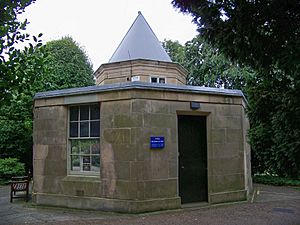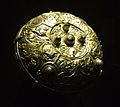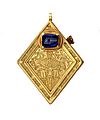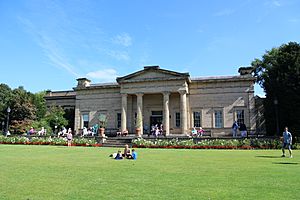Yorkshire Museum facts for kids
 |
|
| Lua error in Module:Location_map at line 420: attempt to index field 'wikibase' (a nil value). | |
| Established | 1830 |
|---|---|
| Location | Museum Gardens, York, England |
| Type | Archaeological and Natural Sciences Museum |
| Visitors | 163,805 (2018–19) |
The Yorkshire Museum is a cool place in York, England, where you can explore amazing things from the past and learn about nature. It first opened its doors in 1830, making it one of the oldest museums around! Inside, you'll find five main collections: living things (biology), rocks and Earth (geology), ancient objects (archaeology), old coins (numismatics), and space (astronomy).
Contents
History of the Museum
The museum was started by a group called the Yorkshire Philosophical Society (YPS). They needed a bigger place for their growing collections of rocks, fossils, and old artifacts. At first, the museum was in a different spot in York, but it quickly became too small.
In 1828, the YPS received a special gift from the King: about 10 acres of land that used to belong to St Mary's Abbey. This land was perfect for building a new museum. The main building, which you see today, was designed by William Wilkins. It has a grand Greek Revival style, like ancient Greek temples. It officially opened in February 1830.
A special rule for the land was that the area around the museum had to be a botanic gardens. So, beautiful gardens were created in the 1830s. Today, these are known as the Museum Gardens. In 1831, an important science group, the British Association for the Advancement of Science, held its very first meeting at the Yorkshire Museum.
Building Changes Over Time
The Tempest Anderson Hall was added to the museum in 1912. It was one of the first buildings made with strong reinforced concrete. This hall is still used today for talks and conferences.
During World War II, in 1942, a bomb nearly hit the museum. The explosion damaged the roof and windows, but thankfully, the main building survived. The museum's curator, Reginald Wagstaffe, helped clean up all the broken glass and scattered specimens.
In 1961, the Yorkshire Philosophical Society gave the museum and gardens to the people of York. This was because of money problems. The City of York Council then took over running the museum. Later, in 2002, the council created the York Museums Trust to manage the Yorkshire Museum, along with the York Castle Museum, York Art Gallery, and the Museum Gardens.
The museum closed for a big makeover in November 2009 and reopened on August 1, 2010. This £2 million project made the inside of the museum look brand new!
Recent Exhibitions and Closures
As of 2018, the museum had several exciting permanent exhibits. These included "Roman York – Meet the People of the Empire," "Medieval York: Capital of the North," and "Yorkshire's Jurassic World."
During the COVID-19 pandemic, the museum had to close its doors to visitors in March 2020. It reopened on July 9, 2021, with a special exhibition featuring a famous painting of King Richard III. The museum then closed for the winter in October 2021 to save resources and do repairs. It reopened again on April 8, 2022, with a new exhibition about the Ryedale Roman Hoard.
Museum Collections
The Yorkshire Museum has four main collections that are considered "nationally and internationally important." These collections started in the 1820s with animal bones and fossils found in Kirkdale Cave in North Yorkshire.
Biology Collection
The biology collection has over 200,000 items, including plants and animals. Most of these are insects! You can also see bones from amazing extinct animals like the great auk and a nearly complete skeleton of a giant moa bird. There are also bones from animals that lived in Yorkshire about 125,000 years ago, like elephants, cave bears, and hyenas from Kirkdale Cave.
Geology Collection
The geology collection holds more than 112,500 rocks, minerals, and fossils. Over 100,000 of these are fossils, including important ones from the Carboniferous, Mesozoic (dinosaur age), and Tertiary periods.
Astronomy Collection
The astronomy collection is mostly kept at the observatory in the museum gardens. Volunteers help run the observatory and show visitors the telescopes.
Archaeology Collection
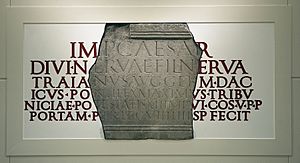
The archaeology collection is huge, with almost a million objects! These items date from around 500,000 BC all the way up to the 1900s. Many of the Roman, Anglo-Scandinavian (Viking Age), and medieval objects were found right here in York and the Yorkshire area.
Cool Objects to See
The museum has many famous and interesting items in its collections.
Geological Finds
- The Middlesbrough meteorite, a space rock that fell to Earth.
- Alan the Dinosaur, the oldest Sauropod fossil found on the Yorkshire coast.
Prehistoric Finds
- The Star Carr Pendant, which is the oldest piece of art from the Mesolithic (Middle Stone Age) period found in Britain.
- Parts of the Star Carr Frontlets, which are ancient headdresses made from red deer skulls.
- The York Hoard of Neolithic (New Stone Age) flint tools.
- The Towton torcs, a pair of gold necklaces from the Iron Age.
Roman Finds
- The Melsonby Hoard, a collection of items from the Iron Age.
- The Wold Newton hoard, a collection of 1,857 coins from the early 300s AD.
- The Head of Constantine the Great, a piece of a marble statue of the Roman emperor Constantine the Great.
- The Statue of Mars, a sculpture of the Roman god of war.
- The Heslington Hoard, a collection of 2,800 coins from the mid-300s AD.
- The Ivory Bangle Lady, a 4th-century skeleton of a woman.
- The Ryedale Hoard, Roman copper artifacts from the 100s AD.
Early Medieval Finds
- The Coppergate Helmet, an amazing 8th-century helmet found in York.
- The Ormside Bowl, a beautiful silver-gilt bowl.
- The Bedale Hoard, a collection of Viking silver jewelry and an Anglo-Saxon sword.
- The Escrick ring, a gold and sapphire finger ring from the Anglo-Saxon period.
- The Gilling sword, a late Anglo-Saxon sword found in a river.
- The Vale of York hoard, a 10th-century silver vessel filled with coins and jewelry.
Medieval Finds
- The Middleham Jewel, a diamond-shaped gold pendant with a sapphire.
- The Cawood sword.
- The gilt-enamel figurine depicting Christ, a small statue found in 1826 and bought by the museum in 2019.
- Objects from the archaeology collection
-
The front of the Middleham Jewel showing the Crucifixion of Jesus
-
The 8th-century Coppergate Helmet
-
The 9th-century Gilling sword with silver decorated handle
-
Carved Medieval Boss from St Mary's Abbey
-
Marble bust of the Roman emperor Constantine the Great
-
The Bedale Hoard of Viking silver and gold
Events and Activities
The museum often holds "Finds Days." On these days, experts from the Portable Antiquities Scheme and museum staff help people identify old objects they've found. This helps build a better picture of the past.
The Yorkshire Philosophical Society also holds monthly talks in the museum's lecture theatre.
Roman Festival
The museum and Museum Gardens have hosted the Eboracum Roman Festival every year since 2016. It's a fun event celebrating York's Roman history!
Curator Battle
During the COVID-19 pandemic when the museum was closed, it started a fun online competition called the 'Curator battle'. Museums from all over the world competed to show off their best objects based on different themes, like the 'creepiest object' or 'sassiest object'. This online event helped millions of people see the museum's collections!
Special Exhibitions
The museum has hosted many special exhibitions over the years.
Past Exhibitions
In 1976, an exhibition called "The Viking Kingdom of York" attracted over 78,000 visitors. Another successful Viking exhibition, "The Vikings in England," opened in 1982 and was seen by over 235,000 people. It even won an award!
In 1984, "A New Look at the Dinosaurs" was a huge hit, with over 320,000 visitors. It was described as "the best thing on dinosaurs you are ever likely to see."
In 2006, the exhibition Constantine the Great: York's Roman Emperor was a very important show. It brought in over 58,000 visitors.
After its big refurbishment in 2010, the museum displayed parts of its Roman collection. You could see a statue of the Roman god Mars and learn about the lives of Romans in York. A special stone inscription, the last known record of the famous lost Roman legion, the Ninth Legion, is also on display.
The facial reconstruction of King Richard III was displayed at the museum from July to October 2013. In 2014, a rare Shakespearean First Folio (an early collection of his plays) was also on display.
In 2016, a unique Mesolithic pendant from Star Carr was first shown to the public. In 2018, the Yorkshire's Jurassic World exhibition, featuring marine and land fossils, was opened by David Attenborough.
Recent Exhibitions
In 2019, the St Mary's Abbey Figurine went on public display. This medieval figurine was found in 1826 and bought by the museum in 2019.
In November 2019, the museum announced that a portrait of King Richard III would be on loan from the National Portrait Gallery. This exhibition opened to the public on July 9, 2021.
The museum reopened on April 8, 2023, with a new exhibition called "The Ryedale Hoard: A Roman Mystery." A family-friendly exhibition called "Mary Anning Rocks!" opened on July 14, 2023, featuring a model of the Statue of Mary Anning.
In February 2024, the museum announced an exhibition about the Mesolithic site of Star Carr called "Star Carr: Life after the ice." This exhibition, which opened on March 22, 2024, includes objects that have never been shown before, like the world's oldest hunting bow!
The Yorkshire Museum Ghost Story
Some strange things were reported at the museum in the winter of 1953 and early 1954. The museum's caretaker, George Jonas, said he saw the ghost of a man in old-fashioned clothes entering the library. He also reported that a book kept falling off its shelf by itself, always on a Sunday evening.
On January 27, 1954, eight people went into the museum library to see if they could witness the event. They signed statements saying they felt a coldness around their legs, saw the book move off the shelf, and even saw its pages still moving when it was on the floor!
See also
 In Spanish: Museo de Yorkshire para niños
In Spanish: Museo de Yorkshire para niños



